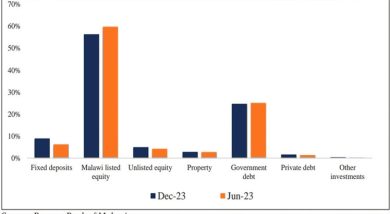Role of central banks in the banking sector
The banking sector plays a key role in the country’s economy as evidenced by, among others, the 2007-2008 credit crunch and global financial crisis (Saunders and Cornett, 1949).
While playing their important roles, financial institutions need to adopt sound credit risk management principles and policies, otherwise they are bound to collapse due to failure to manage credit risk, which has proven to be the biggest single source of risk for most banks (Joseph, 2013).

The Basel Committee in its quest to create sanity in the banking sector around the world prescribes several credit risk management principles which banks in different jurisdictions adopt to effectively manage credit risk exposures within acceptable parameters (Basel, 2000). Such principles help in minimising credit losses thereby maximising the banks’ risk-adjusted rate of return and creating a safely functioning banking sector.
Central banks also play a critical role in enhancing key credit risk management principles amongst banks and ensure a safely functioning banking sector. The following are some of these credit risk management principles according to the Basel Committee, and how the central banks intervene in enhancing such principles and maintain a safely functioning banking sector:
Establishing an appropriate credit risk environment
Banks are encouraged to establish an appropriate credit risk environment and strategy and policies that guide their credit function and operations (Weber and Olaf, 2012). The board must review and approve credit risk strategies, whilst senior management implements this strategy. Any changes to the strategy and policy must be approved by the board to ensure they remain relevant and adequate to reduce credit risk to acceptable levels.
Commercial banks in Malawi for instance have credit committees which drive the credit risk strategy and policy under the leadership of an executive officer, usually the managing director. They also have board credit committees which review and approve the credit risk strategy and policy. Senior management develops policies and procedures for identifying, measuring, monitoring, and controlling credit risk (Clickner, 1967) whilst the board of directors approve and periodically review the credit risk strategy and policy. As a final watch dog, the central bank’s role is to assess the credit risk strategy and policies to ensure that they are effectively implemented to manage credit risk by reducing the levels of nonperforming loans. However, banks are sometimes in breach of their own policies and strategy by practically assuming more credit risk than their defined appetite, leading to high credit losses.
Operating under a sound credit granting process
Banks must operate within sound, well-defined credit-granting criteria, to manage credit risk right from the credit origination stage. This entails understanding the borrower, purpose, structure of the credit, and its repayment source (Grippa and Gornicka, 2016). Credit granting should be only after a thorough assessment of the borrower evaluating the obligor’s character, cash flows, collateral, and non-financial considerations including management track record. The central bank should ensure that banks have clearly documented credit policy and procedures manual, guiding new credits, renewals, and re-financing of existing credits (Hendrik and Lambert, 2019).
Banks are also required to establish overall credit limits for individual borrowers and groups of connected counterparties (Giordani and Tommaso, 1992). Credit facilities to the bank’s related parties including top management must be approved by the board regardless of the amount. Periodically banks must provide a report on all such related party exposures, their balances and performance to the central bank. This mitigates the risks of non-arm’s length lending (Rahman and Khalil, 2019), and granting credit facilities to non-qualifying borrowers leading to increased default and credit losses. Ironically some banks across jurisdictions compromise on the level of scrutiny for the related party borrowers. This has resulted in default, and some banks being penalised for concealing the true status of such related party exposures.
Maintaining an appropriate credit administration, measurement, and monitoring process
Banks should have a system for ongoing administration of various credit risk-bearing portfolios (Basel, 2000). This entails having systems for monitoring the condition of individual credits and determining the adequacy of provisions and reserves (Autoriti Monetari, 2018). This ensures early identification of problematic facilities and taking necessary action towards recovery (Meyer, 2000). Central banks prescribe financial asset classification guidelines for the banks, to classify credits into standard, special mention, substandard, doubtful, and loss categories. This also entails identification of the expected credit loss and establishment of adequate provisions in line with Basel requirements (Basel; 2000). By following the above guidelines, banks are bound to achieve a high-quality credit portfolio thereby improving the profitability and shareholder returns (Mengze and Wei, 2015). The challenge however is that most of the banks are at times obsessed with shareholder value maximisation rather than managing risk by following the rules and procedures on financial asset classification. As such, other banks are reluctant to raise sufficient provisions and classify some facilities as non-performing even though all efforts to recover the debt seem exhausted, this becomes a threat to the safety of the banking sector.
Ensuring adequate controls over credit risk
Banks should independently assess their credit risk management processes and ensure that credit exposures are consistent with prudential standards and internal limits (Bessis, 2015). Internal controls must also be enforced to ensure that exceptions to established policies and limits are approved at the appropriate management level.
Central banks monitor the single lending (obligor) limits across the banks, and their top exposures. Loan requests above the single obligor limit must be authorised by the central bank upon assessing the requirement and the level of credit risk involved. Much as such interventions have been helpful, at times central banks are too strict and rigid to authorise lending above single obligor limit to projects which are critical for the country’s economic development, including the export-oriented projects. This derails development.
In conclusion, central banks across jurisdictions play a key role in managing risk and creating a safely functioning banking sector, which is key to the economic development of any country as it attracts public and investor confidence. To achieve this, compliance by the commercial banks is key, on the other hand central banks need to adopt a principles-based approach to business rather than the rules-based approach to regulate the sector. Governments also need to commit resources to enable central banks to play their roles, otherwise the cost of delaying proper risk management can be extreme, that is failure of the banking system in a country (Andrew Flight: 2004).
Frank Nakoma is a chartered banker writing in his personal capacity. Feedback: fnakoma@yahoo.com





